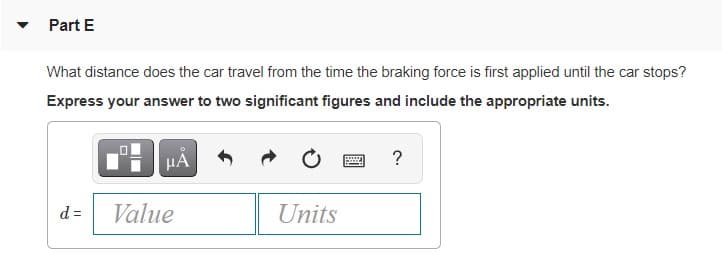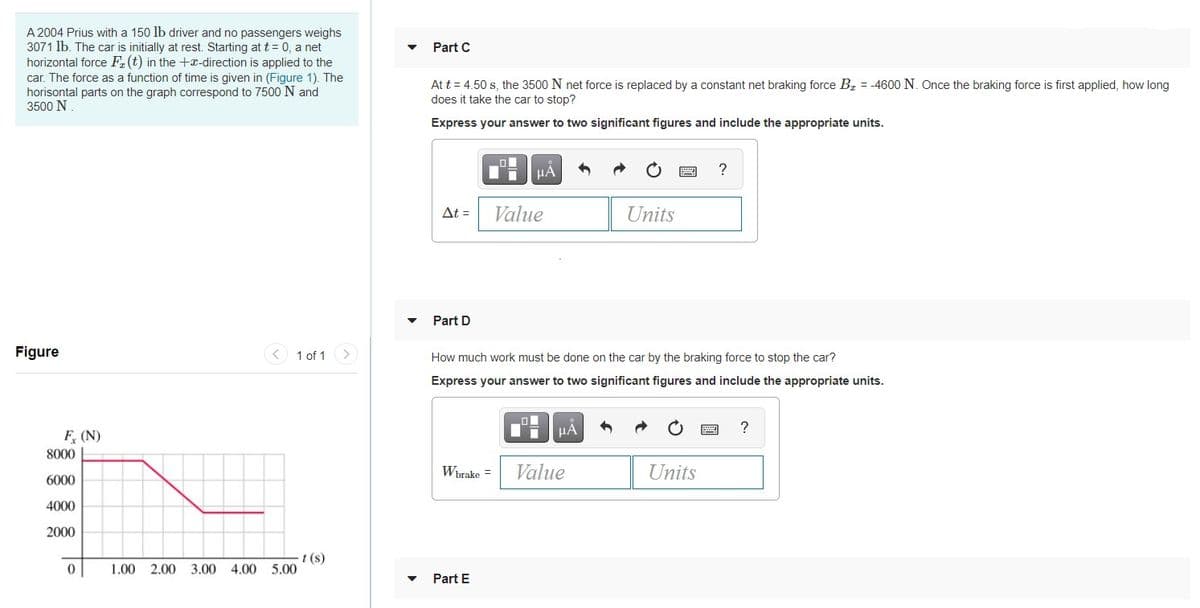College Physics
11th Edition
ISBN:9781305952300
Author:Raymond A. Serway, Chris Vuille
Publisher:Raymond A. Serway, Chris Vuille
Chapter1: Units, Trigonometry. And Vectors
Section: Chapter Questions
Problem 1CQ: Estimate the order of magnitude of the length, in meters, of each of the following; (a) a mouse, (b)...
Related questions
Question

Transcribed Image Text:Part E
What distance does the car travel from the time the braking force is first applied until the car stops?
Express your answer to two significant figures and include the appropriate units.
?
d =
Value
Units

Transcribed Image Text:A 2004 Prius with a 150 lb driver and no passengers weighs
3071 lb. The car is initially at rest. Starting at t = 0, a net
horizontal force F(t) in the +x-direction is applied to the
car. The force as a function of time is given in (Figure 1). The
horisontal parts on the graph correspond to 7500 N and
3500 N
Part C
At t= 4.50 s, the 3500 N net force is replaced by a constant net braking force Bz = -4600 N. Once the braking force is first applied, how long
does it take the car to stop?
Express your answer to two significant figures and include the appropriate units.
HA
At =
Value
Units
Part D
Figure
1 of 1
How much work must be done on the car by the braking force to stop the car?
Express your answer to two significant figures and include the appropriate units.
F, (N)
HA
?
8000
Wbrake =
Value
Units
6000
4000
2000
t (s)
1.00 2.00 3.00 4.00 5.00
Part E
Expert Solution
This question has been solved!
Explore an expertly crafted, step-by-step solution for a thorough understanding of key concepts.
This is a popular solution!
Trending now
This is a popular solution!
Step by step
Solved in 3 steps with 3 images

Knowledge Booster
Learn more about
Need a deep-dive on the concept behind this application? Look no further. Learn more about this topic, physics and related others by exploring similar questions and additional content below.Recommended textbooks for you

College Physics
Physics
ISBN:
9781305952300
Author:
Raymond A. Serway, Chris Vuille
Publisher:
Cengage Learning

University Physics (14th Edition)
Physics
ISBN:
9780133969290
Author:
Hugh D. Young, Roger A. Freedman
Publisher:
PEARSON

Introduction To Quantum Mechanics
Physics
ISBN:
9781107189638
Author:
Griffiths, David J., Schroeter, Darrell F.
Publisher:
Cambridge University Press

College Physics
Physics
ISBN:
9781305952300
Author:
Raymond A. Serway, Chris Vuille
Publisher:
Cengage Learning

University Physics (14th Edition)
Physics
ISBN:
9780133969290
Author:
Hugh D. Young, Roger A. Freedman
Publisher:
PEARSON

Introduction To Quantum Mechanics
Physics
ISBN:
9781107189638
Author:
Griffiths, David J., Schroeter, Darrell F.
Publisher:
Cambridge University Press

Physics for Scientists and Engineers
Physics
ISBN:
9781337553278
Author:
Raymond A. Serway, John W. Jewett
Publisher:
Cengage Learning

Lecture- Tutorials for Introductory Astronomy
Physics
ISBN:
9780321820464
Author:
Edward E. Prather, Tim P. Slater, Jeff P. Adams, Gina Brissenden
Publisher:
Addison-Wesley

College Physics: A Strategic Approach (4th Editio…
Physics
ISBN:
9780134609034
Author:
Randall D. Knight (Professor Emeritus), Brian Jones, Stuart Field
Publisher:
PEARSON